Let's see the glimpse below,
- Welcome to the Future of Hiring
- The Pain Points of Traditional Hiring
- Enter HR Automation: A New Era in Recruitment
- The Magic Behind HR Automation Tools
- The Role of Automation in Recruitment
- Why Automation is Your Recruitment Superpower
- Overcoming Barriers to HR Automation Adoption
- What’s Next? The Evolution of HR Automation
- Your Blueprint to Revolutionize Recruitment
- How Yoroflow Can Be Your Recruitment Champion
- Ready to Revolutionize Your Recruitment?
Welcome to the Future of Hiring
Imagine this: You’ve just posted a job opening and are immediately overwhelmed with 250 resumes. Sorting through them will take hours—or even days. Meanwhile, 60% of job seekers expect a response within a week, and top candidates are off the market in just 10 days. Does this sound familiar?
Recruitment doesn’t have to be this way. With HR automation, these challenges have become a thing of the past. Automation tools can screen 1,000 resumes in seconds, saving up to 23 hours per hire. Applicant tracking systems (ATS) use AI to identify top talent, improving candidate matching by 80% while reducing human bias.
But it’s not just about speed. Automation enhances the candidate's experience, with chatbots providing 24/7 support and automated emails keeping candidates informed. Companies using automated scheduling tools report a 50% reduction in time-to-hire, gaining a competitive edge in a market where speed matters.
This isn’t just innovation—it’s a necessity. With the global recruitment software market projected to reach $3 billion by 2025, businesses that embrace automation will lead the hiring revolution. Welcome to the future of recruitment, where efficiency meets excellence, and hiring headaches become history.
Ready to join the ranks of organizations saving 44% of their recruiters' time with AI tools? Dive into this whitepaper to explore how HR automation can help you not just hire, but hire smarter and faster, revolutionizing recruitment for the digital age.
The Pain Points of Traditional Hiring
Recruitment, in its conventional form, presents several challenges that limit efficiency and scalability, especially in today’s competitive job market.
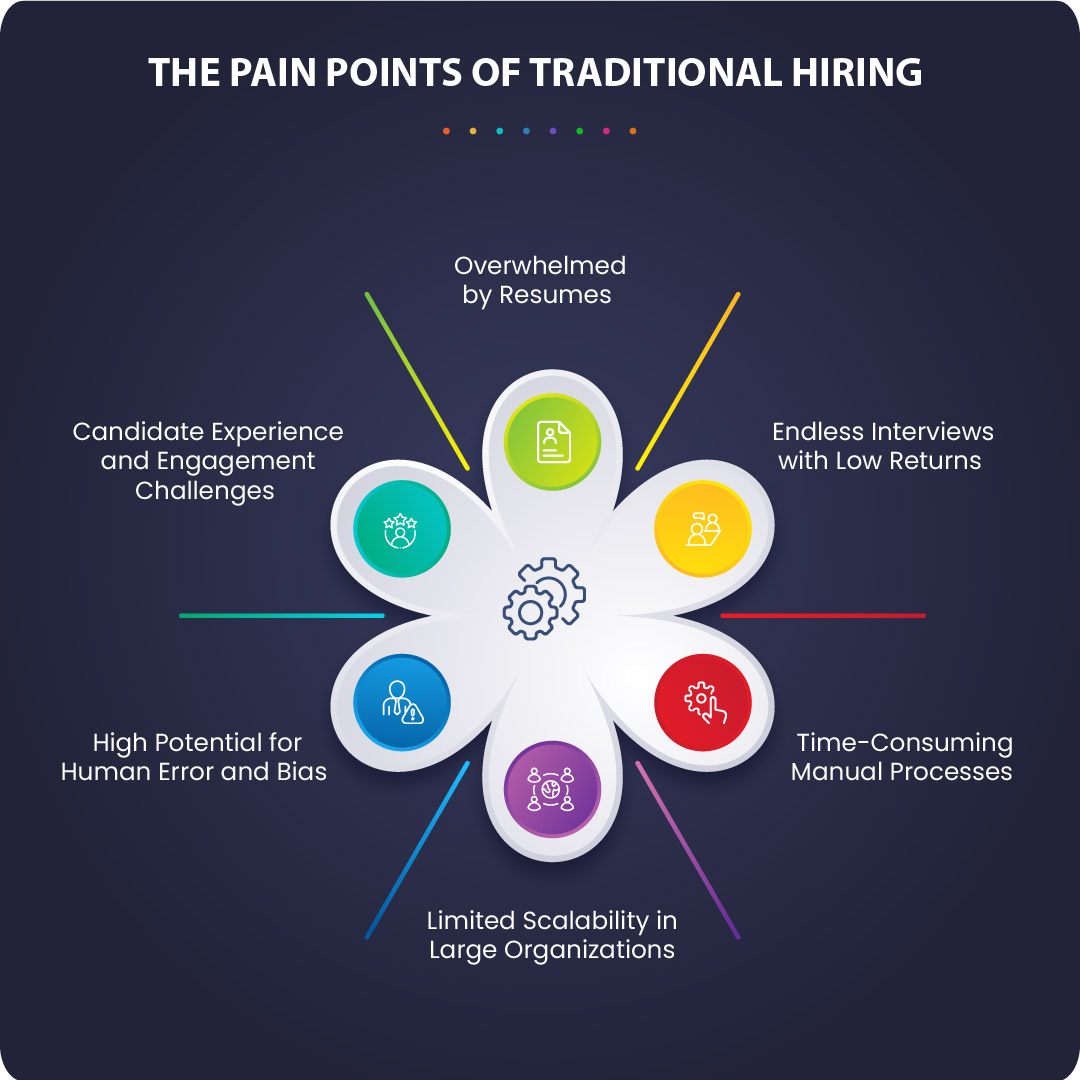
Overwhelmed by Resumes
For each job posting, HR professionals often face an overwhelming number of applications. According to a LinkedIn report, 75% of resumes received for a role are unqualified, making manual shortlisting a time-consuming task.
Endless Interviews with Low Returns
Research highlights that only 12% of applicants progress beyond the initial screening stage, often resulting in wasted hours spent on unproductive interviews. This inefficiency is a key factor slowing down recruitment cycles in traditional models.
Time-Consuming Manual Processes
On average, recruiters spend 23 hours per hire on repetitive tasks like screening resumes, scheduling interviews, and following up with candidates. Such inefficiencies often delay hiring decisions, as noted in reports from Mya Systems and Carv AI.
Limited Scalability in Large Organizations
Traditional hiring models often fail to scale efficiently in larger organizations. A study by McKinsey reveals that inconsistent processes and limited technological adoption hinder recruitment scalability for 60% of enterprises.
High Potential for Human Error and Bias
Human-led hiring processes are prone to unconscious bias, which can affect diversity and hiring outcomes. According to UC Berkeley, AI tools used in hiring reduced bias by 6%, emphasizing the need for automation in recruitment.
Candidate Experience and Engagement Challenges
Traditional methods often result in poor candidate experiences, as noted by LinkedIn Talent Insights, with 58% of candidates declining offers after negative interactions during recruitment. This significantly impacts employer branding and the ability to attract top talent.
Enter HR Automation: A New Era in Recruitment
HR Automation: What It Is and Why It Matters
HR automation refers to the use of technology to streamline and enhance various recruitment processes. From resume screening to interview scheduling and candidate engagement, automation tools significantly reduce the time and effort required for these tasks. According to a report by McKinsey, companies adopting HR automation can save up to 40% in recruitment-related costs. As the talent pool becomes more competitive, the need for faster, more efficient hiring processes is becoming increasingly critical.
By utilizing AI, machine learning, and automation tools, HR departments are able to make quicker, data-driven decisions while reducing the administrative burden on hiring managers and HR professionals. This shift not only improves efficiency but also results in better hiring outcomes, as it enables recruiters to focus on high-value activities, such as interviewing top candidates, rather than spending time on repetitive tasks.
How AI, Chatbots, and Automation Tools Are Transforming Recruitment
AI and chatbots are at the forefront of HR automation, providing tools that assist with everything from initial candidate engagement to final hiring decisions. AI-driven recruitment platforms can analyze resumes, rank candidates, and even conduct preliminary interviews through automated chatbots. According to a Gartner survey, organizations using AI-driven recruitment solutions have cut down their time-to-hire by 35%. This technology not only accelerates hiring but also helps in eliminating human biases, ensuring that all candidates are evaluated on their skills and experience rather than subjective factors.
Chatbots, for example, can handle the initial stages of candidate interaction, asking key pre-screening questions, collecting data, and even scheduling interviews. This automation ensures that HR professionals only spend their time on the most promising candidates, enhancing productivity and reducing the likelihood of candidate drop-off during the hiring process.
What HR Automation Brings to the Table
HR automation brings several key benefits to the recruitment process:
- Increased Efficiency: Automation tools allow recruiters to process large volumes of applications in a fraction of the time it would take manually. According to Carv AI, using automation tools can reduce the time spent on candidate sourcing by 50%.
- Improved Candidate Experience: With chatbots engaging candidates instantly and keeping them informed throughout the process, candidate satisfaction rises. 73% of candidates report a positive experience with automated hiring systems.
- Cost Savings: By cutting down on manual tasks and speeding up the hiring process, HR automation reduces recruitment costs. Companies using automated tools can save up to 30% per hire.
- Scalability: Automation can easily handle high-volume hiring needs, which is particularly beneficial for large organizations or those undergoing rapid expansion. This scalability ensures that HR teams are equipped to manage fluctuating hiring demands without compromising quality or speed.
- Reduced Bias: AI systems are designed to remove human bias from the hiring process, helping companies foster diverse and inclusive workplaces. A study by Harvard Business Review revealed that AI-driven platforms can help reduce bias by as much as 50%, ensuring fairer evaluations of all candidates.
The Magic Behind HR Automation Tools
HR automation tools have become game-changers in modern recruitment, offering advanced features that streamline processes, enhance candidate experiences, and reduce hiring costs. Here's a look at some of the key technologies transforming the landscape.
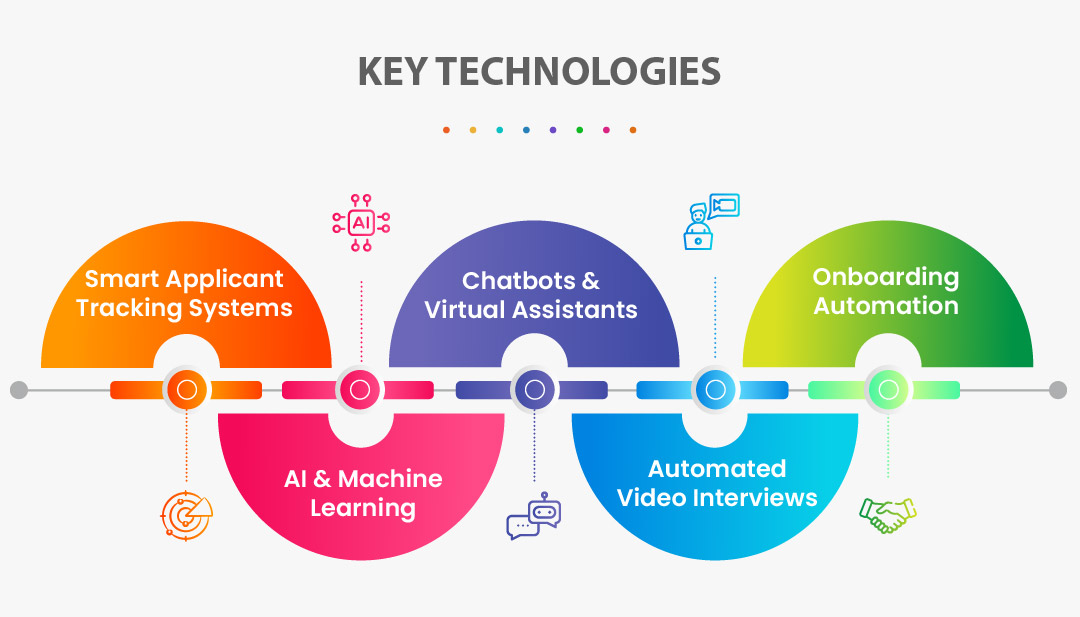
Smart Applicant Tracking Systems (ATS): Fast-track Your Hiring with AI-Powered Filters
A Smart ATS uses AI filters to quickly assess resumes against job descriptions, rank candidates, and suggest the best-fit hires. According to Glassdoor, 75% of resumes are filtered out before reaching a human. This automation saves time, allowing recruiters to focus on top-tier candidates, reducing time-to-hire.
AI & Machine Learning: Match the Right Candidates with the Right Jobs—Automatically
AI and machine learning algorithms go beyond resume analysis by predicting which candidates will succeed in a role, considering factors like past hiring patterns and employee success rates. According to Harvard Business Review, AI-driven platforms reduce time-to-hire by 35% and improve retention by matching candidates to the right roles.
Chatbots & Virtual Assistants: Keep Candidates Engaged 24/7 with Personalized Interactions
Chatbots and virtual assistants have revolutionized candidate engagement, providing real-time, 24/7 interactions with applicants. These AI-driven tools can answer questions, schedule interviews, and provide updates throughout the hiring process. According to Mya Systems, 72% of candidates report a positive experience with chatbots, citing faster responses and greater clarity throughout their journey. Chatbots also help reduce recruiter workload by automating initial screening, making recruitment processes more efficient.
Automated Video Interviews: Cut Through the Noise with Seamless, Data-Driven Interview Platforms
Automated video interviews allow candidates to answer pre-set questions at their convenience, with AI analyzing responses for keywords, tone, and behavior. According to HireVue, this process speeds up hiring by 50%, providing deeper insights into candidates’ capabilities. It also helps reduce unconscious bias, leading to more objective hiring decisions.
Onboarding Automation: Seamlessly Transition from Hire to Onboard—No Manual Work Required
Onboarding automation streamlines new hire transitions by automatically generating offer letters, collecting documents, and setting up resources before the first day. According to WorkBright, automated onboarding leads to 50% faster ramp-up times, improving productivity and reducing turnover. It also ensures compliance and secures sensitive employee data.
The Role of Automation in Recruitment
Automating Repetitive Tasks
Automation in recruitment revolutionizes traditional processes by handling repetitive tasks such as job postings, resume screening, and interview scheduling. AI-powered Applicant Tracking Systems (ATS) can post job openings across multiple platforms and filter resumes based on pre-defined criteria, significantly reducing the time spent on manual sorting. According to Jobvite, automated resume screening can cut hiring time by 60%, while interview scheduling tools save recruiters hours by managing appointments and avoiding scheduling conflicts. This allows HR professionals to focus on more strategic aspects of hiring, like candidate engagement and interviews.
Enhancing Candidate Experience with Chatbots and Self-Service Portals
The candidate's experience is crucial for attracting top talent. Automation tools like chatbots and self-service portals enhance this by offering quick, personalized interactions. Chatbots provide real-time communication, answering questions, and scheduling interviews. Mya Systems reports that 72% of candidates appreciate faster responses. Self-service portals let candidates track applications, submit documents, and complete assessments conveniently, boosting transparency and reducing manual tasks. HireVue notes that candidates feel more empowered when managing applications themselves. These tools streamline recruitment, improve the candidate's experience, and enhance an organization's reputation.
Using AI to Minimize Unconscious Bias in Candidate Selection
AI minimizes unconscious bias in recruitment by evaluating candidates based on skills, experience, and qualifications, rather than demographic factors like gender, race, or age. Harvard Business Review highlights that AI-driven tools reduce human subjectivity, leading to fairer hiring practices. LinkedIn reports AI platforms have increased diversity by 30%. AI’s ability to assess large volumes of candidates objectively ensures a more inclusive hiring process. By focusing on merit, AI fosters diversity and reduces bias, enhancing fairness and efficiency in recruitment. This transformation is pivotal in creating equitable, skill-based hiring practices.
Why Automation is Your Recruitment Superpower
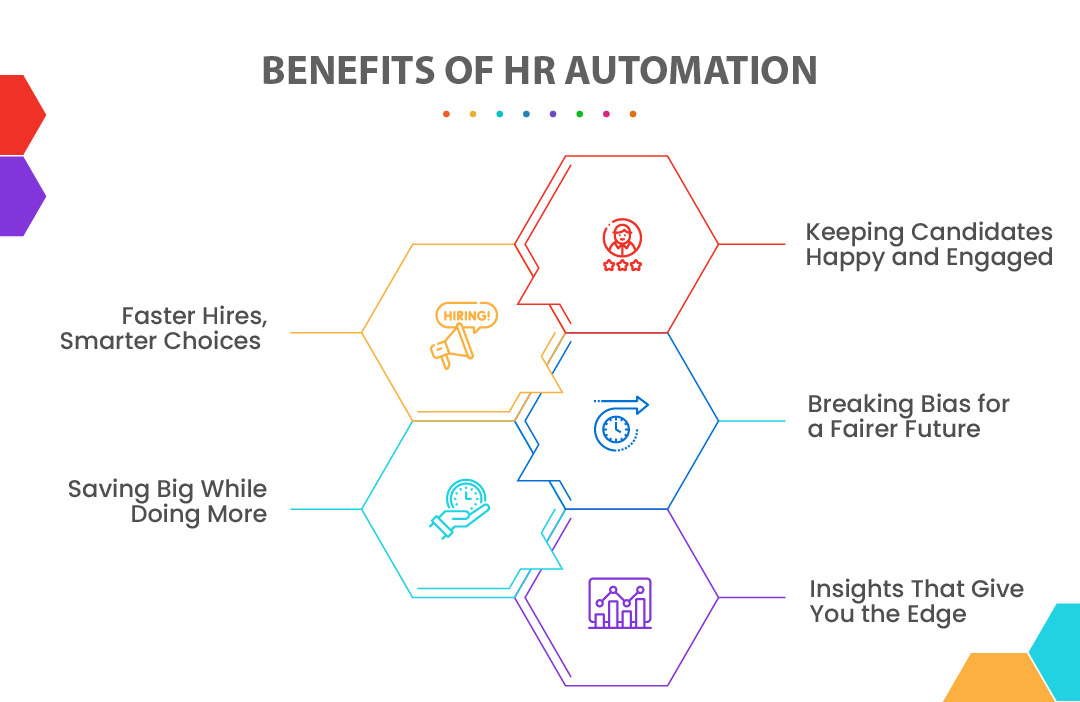
Faster Hires, Smarter Choices
Automation speeds up the hiring process by handling repetitive tasks like screening resumes and scheduling interviews, giving recruiters more time to focus on top candidates. AI tools can analyze applications quickly and match the best candidates to roles, making hiring faster and more efficient. This not only reduces time-to-hire but also ensures better decisions based on data-driven insights rather than intuition alone.
Saving Big While Doing More
Automating tasks such as job postings and resume screening saves labor costs while increasing productivity. Organizations can handle a larger pool of candidates without needing to expand their team, resulting in cost-effective recruitment strategies. By focusing on strategic tasks and automating routine work, recruiters can do more with fewer resources, contributing to significant savings.
Keeping Candidates Happy and Engaged
Automation keeps candidates engaged by providing instant responses to queries through AI-powered chatbots and offering self-service portals for tracking applications. This immediate communication fosters a positive candidate experience and keeps potential hires informed throughout the process. Maintaining transparency and engagement during recruitment enhances your employer brand and encourages candidates to stay interested.
Breaking Bias for a Fairer Future
AI-driven recruitment tools help minimize unconscious bias by evaluating candidates based on skills, experience, and qualifications rather than personal characteristics such as gender, age, or ethnicity. This promotes fairness and inclusivity by ensuring all candidates are evaluated equally, leading to a more diverse and balanced workforce. These tools allow organizations to make more objective, merit-based hiring decisions.
Insights That Give You the Edge
Automation platforms provide valuable data that helps recruiters make informed decisions about their hiring processes. Through advanced analytics, organizations can gain insights into hiring trends, candidate performance, and potential hiring challenges, allowing them to refine their strategies. This data-driven approach ensures smarter decision-making and keeps recruitment aligned with the company's long-term goals.
Overcoming Barriers to HR Automation Adoption
Adopting HR automation can revolutionize recruitment and employee management, yet it’s not without challenges. Overcoming these obstacles requires strategic planning and effective communication.
Resistance to Change
HR teams accustomed to manual processes may hesitate to adopt automation, fearing job redundancy or a loss of the human touch. To counter this, organizations should emphasize how automation enhances—not replaces—HR roles by reducing repetitive tasks and allowing teams to focus on strategic initiatives. Transparent communication about the benefits, coupled with training and change management programs, can help ease concerns and build trust among HR professionals.
Initial Investment and ROI Concerns
The cost of implementing HR automation tools is a common barrier, especially for smaller organizations. However, these tools offer significant long-term savings through streamlined operations, reduced time-to-hire, and lower turnover rates. Demonstrating measurable benefits—such as improved efficiency and higher employee satisfaction—can alleviate ROI concerns. Sharing case studies and benchmarking reports showing successful automation adoption in similar organizations further validates the investment.
Data Privacy and Security
Handling sensitive employee and candidate information makes data security a top concern. Organizations must select tools that adhere to compliance standards such as GDPR or CCPA. Features like encryption, access control, and regular audits are essential for safeguarding data. Additionally, providing staff with training on cybersecurity best practices ensures that data is handled responsibly throughout the organization.
Integration Challenges with Legacy Systems
Integrating modern automation tools with outdated HR systems can create technical and operational hurdles. To overcome this, organizations should prioritize tools offering robust APIs or middleware that facilitate seamless integration. A phased implementation approach reduces the risk of disruption, allowing teams to gradually adapt while maintaining ongoing operations. Partnering with vendors offering strong technical support also ensures smoother transitions.
What’s Next? The Evolution of HR Automation
As recruitment automation continues to transform the hiring landscape, the next frontier will bring even more sophisticated tools and processes, blending cutting-edge technologies with a human-centric approach.
The Future of Hiring
Emerging technologies like AI, blockchain, and generative AI are set to redefine recruitment by making it more efficient, transparent, and personalized.
- Artificial Intelligence (AI) will move beyond simple resume parsing to advanced predictive analytics, assessing not just a candidate’s current fit but their long-term potential within an organization. AI tools will become mentors for candidates, offering career guidance, real-time feedback, and tailored job suggestions, while simultaneously providing recruiters with deeper insights into talent pools.
- Blockchain will revolutionize verification processes. Decentralized systems will allow recruiters to instantly authenticate credentials, reducing fraudulent claims about education, certifications, or experience. This trust-driven approach will streamline background checks and save time.
- Generative AI will innovate job descriptions, employee training programs, and interview simulations. For example, it could create personalized interview questions or even virtual environments tailored to assess specific skills.
What Businesses Should Expect in the Next 5-10 Years
Recruitment will become more personalized and inclusive, leveraging automation to enhance the human element.
- Human-Centric Tools: Future platforms will integrate emotional intelligence, tailoring communications and processes to individual candidate needs. Chatbots might evolve into conversational agents that offer empathetic support during job searches.
- Diversity and Inclusion: Automation will continue breaking down biases by ensuring hiring decisions are skill-driven and impartial. Algorithms will further refine their ability to identify diverse talent pools and address systemic inequities.
- Lifelong Learning Integration: Recruitment platforms will merge with upskilling systems, providing pathways for candidates to bridge skill gaps. This will be crucial as industries adapt to new technologies and roles evolve.
- Hybrid and Remote Recruitment Excellence: Tools will focus on managing the challenges of global hiring, from time zone coordination to legal compliance. AI-driven platforms will make it easier to onboard and manage remote teams effectively.
Your Blueprint to Revolutionize Recruitment
The future of recruitment lies in leveraging advanced technologies to create smarter, faster, and more personalized hiring processes. By following this step-by-step blueprint, organizations can transition to an automated, data-driven recruitment model that enhances both efficiency and candidate experience.
Steps to Start Automating Your Hiring Process
1. Assess Current Recruitment Challenges:
Begin by identifying bottlenecks in your current hiring workflow. Are manual resume screenings slowing you down? Are candidate engagement rates low? Mapping out pain points will help determine which automation tools to prioritize.
2. Choose the Right Automation Tools:
Look for platforms that align with your organizational needs, such as Applicant Tracking Systems (ATS), AI-driven chatbots, and video interviewing tools. Prioritize scalability and ease of integration with existing HR systems.
3. Implement Predictive Analytics for Workforce Planning:
Predictive analytics uses historical hiring data and market trends to anticipate future talent needs. These tools enable HR teams to forecast staffing requirements and proactively fill roles before they impact business operations. For instance, companies can use predictive models to identify skills gaps or plan for seasonal hiring spikes.
Leveraging Generative AI for Personalized Candidate Engagement
Generative AI elevates recruitment by offering hyper-personalized interactions:
- Job Descriptions and Emails: AI can craft tailored job descriptions and emails that resonate with target candidates, improving application rates.
- Real-Time Feedback: AI-driven tools provide immediate, meaningful feedback to candidates during the process, enhancing satisfaction.
- Candidate Engagement: Chatbots powered by generative AI can answer queries, provide updates, and suggest relevant roles, keeping candidates engaged without HR intervention.
How Yoroflow Can Be Your Recruitment Champion
Yoroflow’s HR automation tools are designed to empower recruitment teams by streamlining workflows, improving candidate engagement, and enhancing decision-making. Tailored to the needs of modern HR teams, these solutions tackle recruitment challenges with advanced automation and AI-driven features.
Features of Yoroflow’s HR Automation Solutions
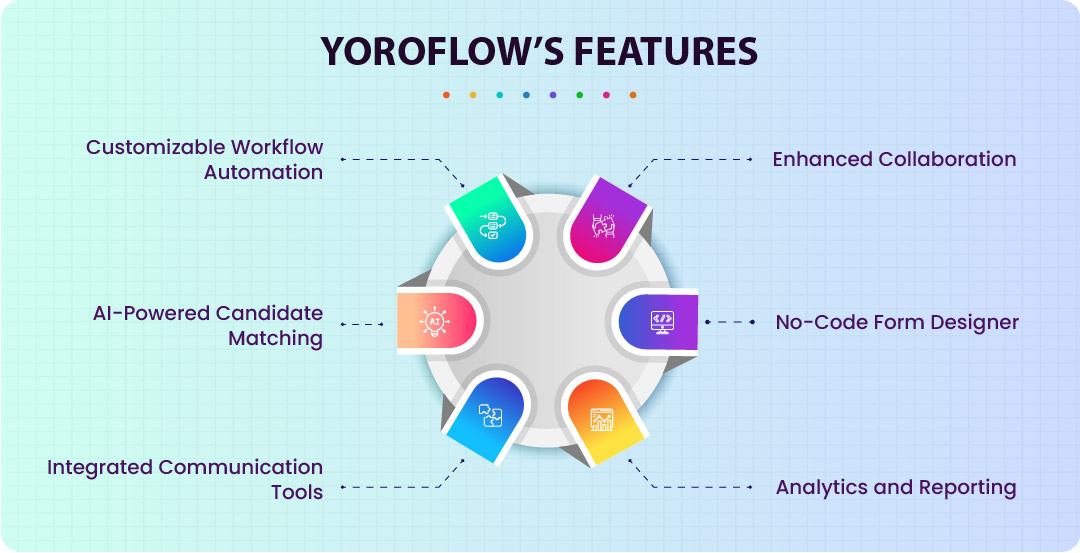
Customizable Workflow Automation:
Yoroflow automates routine tasks such as resume screening, interview scheduling, and offer letter generation, significantly reducing manual effort and speeding up the recruitment process. It also allows HR teams to design customized workflows tailored to specific roles or departments, providing flexibility and efficiency in managing recruitment across diverse teams and positions. This automation not only streamlines operations but also ensures consistency and accuracy in the hiring process.
AI-Powered Candidate Matching:
Yoroflow uses advanced AI to match candidates to jobs based on their skills, experience, and cultural fit, significantly reducing human bias. By relying on data-driven algorithms, it ensures that hiring decisions focus on qualifications rather than unconscious preferences, promoting fairness and inclusivity in the recruitment process.
Integrated Communication Tools:
Yoroflow enables real-time communication with candidates through automated email updates, reminders, and chatbots, ensuring they stay informed throughout the hiring process. By maintaining continuous engagement, it helps create a positive candidate experience, keeping applicants interested and involved. This proactive approach leads to higher candidate satisfaction and better retention during recruitment.
Enhanced Collaboration:
With Yoroflow’s collaborative features, HR teams can work seamlessly across departments and locations, improving teamwork and decision-making during recruitment. The platform’s collaboration tools enable HR professionals to share feedback, track progress, and ensure alignment across the hiring team, making the recruitment process more cohesive and efficient.
No-Code Form Designer:
Yoroflow includes a no-code form designer, empowering HR teams to easily create and customize forms for job applicants, candidates' assessments, and other recruitment tasks. This intuitive tool reduces the need for technical expertise, allowing teams to quickly adapt to changing requirements and streamline the data collection process.
Analytics and Reporting:
Yoroflow provides actionable insights into hiring trends, time-to-fill, and candidate sources, enabling HR teams to refine their recruitment strategies. By analyzing data, it identifies the most effective hiring channels, highlights bottlenecks, and helps optimize processes for better candidate sourcing and quicker, more informed hiring decisions. This data-driven approach boosts efficiency and improves overall recruitment outcomes.
Benefits of Yoroflow for HR Teams and Businesses
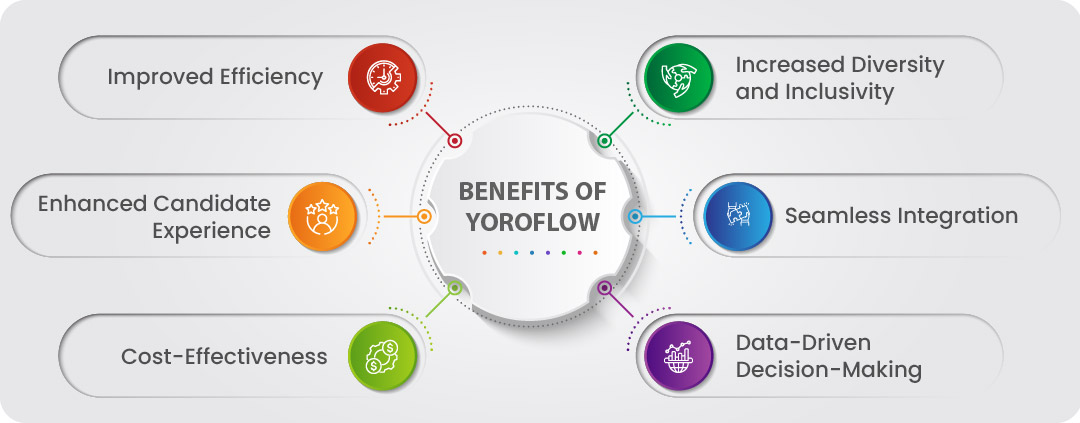
Improved Efficiency:
By automating repetitive tasks, Yoroflow frees HR teams to focus on strategic activities like candidate engagement and employer branding.
Enhanced Candidate Experience:
Yoroflow ensures timely communication with applicants, offering updates and scheduling flexibility, leading to higher candidate satisfaction.
Cost-Effectiveness:
Automation reduces time-to-hire and minimizes the cost of prolonged recruitment processes.
Increased Diversity and Inclusivity:
AI-driven candidate matching helps eliminate unconscious bias, leading to a more diverse workforce.
Seamless Integration:
Yoroflow easily integrates with existing HR systems, reducing adoption challenges and ensuring smooth transitions.
Data-Driven Decision-Making:
Insights from Yoroflow's analytics enable HR teams to identify bottlenecks, optimize workflows, and forecast hiring needs effectively.
Ready to Revolutionize Your Recruitment?
HR automation has become an essential tool for modern hiring, redefining how organizations attract, evaluate, and onboard talent. It’s no longer just a trend; it’s the cornerstone of an efficient and future-ready recruitment process. By adopting automation, businesses can overcome traditional hiring challenges like inefficiency, human bias, and poor candidate engagement, making their recruitment efforts faster, smarter, and more inclusive.
Embracing HR automation might feel daunting, but with solutions like Yoroflow, the transition is smooth and highly rewarding. Yoroflow simplifies the process by offering user-friendly tools like customizable workflows, AI-powered candidate matching, no-code form designers, and analytics that provide actionable insights. Whether you’re a small business or a large enterprise, Yoroflow ensures that your recruitment system evolves to meet today’s demands while staying adaptable for the future.
Final Thoughts
The time to innovate is now. HR automation empowers businesses to elevate their hiring strategies, creating seamless processes that attract top-tier talent while reducing costs and manual effort. With tools like Yoroflow, your team can focus on what truly matters: building a workforce that drives success. Ready to innovate, automate, and elevate? The future of recruitment is waiting.